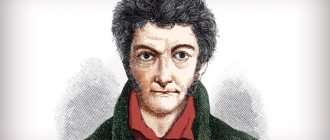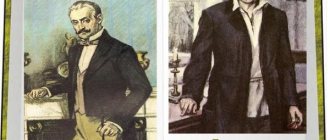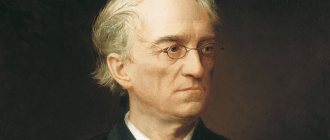Parents of Pavel Petrovich
Years of life and death of Pavel Petrovich 1879 - 1950.
The writer was born on January 27 in a family of workers in the city of Syset. The town belonged to the Yekaterinburg district and had the status of an industrial center.
The writer’s father was Pyotr Vasilyevich Bazhev (the parent’s surname was originally spelled with the letter “e”). This man worked, if translated into modern language, as a workshop foreman. His penchant for alcohol aroused an “evil tongue” in Pyotr Vasilyevich.
He criticized his own superiors, and it was because of this that he often quit his job. However, he was a knowledgeable and irreplaceable worker, so one day he was reinstated in his previous position. The next libation again left him without a job, which gave way to long persuasion to return him to service.
Mother was Augustina Stefanovna (nee Osintseva). She originally came from a family of Polish peasants. The woman did not have a permanent place of work; as is now commonly believed, she was classified as a housewife. She spent all day doing housework, and spent the evenings doing handicrafts.
By the way, she was a craftswoman and made knitted lace stockings for sale. These unique products were very popular among the wives of local authorities. This is what kept the family from falling apart during the frequent dismissals of Pyotr Vasilyevich from his position. Over the years, painstaking work in low light had a detrimental effect on the vision of the writer’s mother.
Childhood
Pavel was the only child in the family. The grumpy father treated his own differently from someone else's; he adored his son. Everything was allowed and forgiven for the future writer.
He was enveloped in the warmth and affection of both loving parents. They tried in every possible way to brighten up their son's childhood.
In the evenings, especially in winter, Pasha enjoyed tales about the working people of the Urals. He was fascinated by fantastic stories about the mistress of the local mountains, about a gold snake and mines containing valuable rocks and gems. These tales captivated the boy, awakening and shaping his imagination.
Education and upbringing
The boy grew up as an intelligent and inquisitive youth. He easily and without extra effort graduated from a four-year primary school, which was located in his town. It so happened that a volume of Pushkin’s poems that accidentally fell into the boy’s hands was learned by heart.
The writer recalled that the librarian, giving him the book, jokingly demanded that the boy learn the volume by heart. The dutiful child did not take the joking tone and learned everything as he was told.
This fact amazed his teacher. He, having talked with the boy’s parents, persuaded them to send their son for further education, seeing the student’s enormous potential. Having learned about the deplorable state of the family, he took everything into his own hands. The teacher took Pavel to Yekaterinburg and introduced him to his friend, who works as a veterinarian.
This man's name was Nikolai Smorodintsev. It was he who oversaw the young man’s education in subsequent years, and later became a loyal friend. It was to this man that Bazhov owed the chance to continue his studies.
Seminary studies
Having acquired the patronage of Nikolai Semyonovich Smorodintsev, at the age of ten Pavel easily entered the seminary, which was located in Yekaterinburg. This educational institution had the lowest tuition fees, so we chose it. Renting a house for the family was impossible due to the deplorable financial situation, so the veterinarian offered his hospitality to the boy.
The big city amazed the boy; the multi-story buildings built of stone were especially memorable. The young man was also amazed by the railway, popularly called cast iron. The cultural life of this city attracted the newly minted student with its colors.
After studying for some time, the young man was provided with other housing by the school. For these needs, the educational institution rented several rooms in a private house for nonresident students. A special person (inspector) was assigned to the group of young people. He kept order in the hostel.
At first the guys disliked this man, but later the writer spoke warmly about him. The inspector was an educated man, although a strict official. He instilled in the children a love of literature, often reading them stories by Kuprin, Tolstov and Gogol.
Pavel did well in his studies and had the best grades. The student spent his summer holidays at home with his parents. In the evenings, with the rest of the boys, he ran to the warehouses for storing firewood. Vasily Alekseevich Khmelin worked there as a watchman. Among the guys they called him Grandpa Sunny.
He attracted young people with his unusual stories in the genre of folklore and fantasy. This man knew how to tell stories very well, his stories were easily and long remembered. It was these Ural tales that colored the writer’s subsequent works in a unique light. Subsequently, it was this circumstance that aroused interest in collecting local folklore, figures of speech, fairy tales and legends of these places.
Upon completion of his studies, the young man was offered to enter the theological seminary, but he refused. He was frightened by the fact that he would have to leave for Perm, separating himself a greater distance from his family. He also did not feel any inclination towards spiritual activity.
Pavel shared more revolutionary views, so he decided to stop his education there. During his student years, he read forbidden revolutionary literature and was interested in philosophy and the works of Darwin. This determined his future fate.
On the observation deck
Zlatoust is famous for stone processing, so there are many stone sculptures in Bazhov Park. After examining the stone sculptures, guests open the massive oak door on which bronze lizards bask and go to the observation deck. The sculptures on it are unique:
- The nine-meter waterfall is striking. The stone for it was taken from the quarries of the region. In total, 500 tons of stone blocks were used.
- In the center of the site is an oak tree, a masterpiece of Perm blacksmiths. The masters put their souls and broad meaning into it, which is as follows. Everything is harmonious in nature, man is a part of it. There is enough space under the sun for everyone, so peace should reign on earth. These words are confirmed by the sculptures of a fox and a hare, which are peacefully located under an oak tree, and a forest boar looks up with interest, not trying to undermine the roots of the mighty tree. Visitors linger near the miracle tree for a long time: they need to find 20 characters hidden in the iron leaves. If you see everyone, life will become happy.
Teaching activities
I tried to enter a secular university and failed. This prompted Pavel to take up teaching. A factor that influenced this decision was the mother, who lost her sight and was left alone after the death of her father. She needed help, including financial support.
Pavel Bazhov (standing on the left in the photo) with fellow teachers
At first, the young man took up tutoring. His earnings also came from writing articles for newspapers. This man subsequently worked as a teacher for a total of about 20 years. The path of teaching the native language began in the village of Shaidurikha, which was located not far from the city of Nevyansk.
Then he worked at the Kamyshlov Theological School, and subsequently studied at the diocesan educational institution for girls, located in Yekaterinburg. As a teacher he was attentive and kind, this contributed to the adoration of his students. Pavel Petrovich's lessons were the most favorite subject among students.
During this time, Bazhov did not stop collecting Ural figures of speech, quotes, riddles, folklore and fairy tales. When sending students on summer vacation, they were given the task of learning and writing down everything connected with it. The teacher carefully recorded all the information.
Subsequently, becoming one of the most famous folklorists of his time, he did a lot of work in this field, independently looking for interesting words, proverbs and sayings. The dialectical expressions collected and used in works can only be found in modern dictionaries.
From the history of the park
The Bazhov Park is located in a picturesque place on Krasnaya Gorka, from where you can admire Tagonay and Kosotur. He, like Chrysostom, has his own history. 20 years ago, on the initiative of the city’s leading enterprise, which also acted as an investor in the transformation, the reconstruction of this place began:
- A square was laid out in honor of John Chrysostom, the patron saint of the city.
- A few years later, a bell tower was erected, the height of which exceeded 50 meters.
- A chapel dedicated to St. John Chrysostom was opened in the tower.
- At the top of the tower there is a huge bell with a diameter of one meter, weighing more than a ton. Any visitor, having climbed to the very top of the tower, can try to hit the bells, and then a unique ringing will be heard.
Like a legend, local residents tell about the deeds of the breeder Mosolov, who revered the saint and gave the new city his name.
Later, the management of the Zlatoust plant continued work on Krasnaya Gorka. A monument to Yuri Gagarin and a submarine appeared in the park - evidence of the skill of the workers of the Ural factories who developed and produced missiles for submarines.
Creativity of P. P. Bazhov
In the 20s of the last XIX century. a move took place from Kamyshlov, where the Bazhov family had lived until that time, to Yekaterinburg. In a big city, Bazhov worked in print publications. Four years later, Bazhov released his first collection, which turned out to be very popular among readers. The book was called “The Ural Were.”
Work on these tales was carried out in free time, after the main work activity. Creative activity was not a burden to the writer; it was always done with pleasure. The authorities, noting Bazhov's success, ordered the following literary works. From the author’s pen of Pavel Petrovich came such stories as: “Towards calculation”; “For Soviet truth”; “First draft fighters” and others.
In the 30s, the purge of the ranks of power was in full swing, and the writer did not escape the same fate. In 1937, the writer was accused of being loyal to Trotsky and was deprived of his party card and job.
Left out of work, Bazhov took up writing fairy tales, remembering the stories of Grandfather Sunny and finding solace in this activity. By this time, the children had grown up and helped keep the family afloat. Everyone worked and had a stable income.
In 1937, Bazhov’s first book of fairy tales, “The Malachite Box,” was published.
The success of these stories was enchanting; the collection was immediately swept off the shelves of second-hand bookstores.
The resulting excitement for this book literally revived the writer’s spirit. The stories that Bazhov collected in the Urals and then published were close to the local population.
After the start of the war, the writer worked on publishing almanacs. This was done to raise the morale of the people serving on the front line. True, this did not last long; the writer’s vision began to decline sharply. After this, Bazhov occupied himself with lecturing, and subsequently headed the writers' organization in the city of Sverdlovsk.
The beginning of a creative journey
Pavel Petrovich Bazhov's first writing activity occurred during the Civil War. It was then that he began working as a journalist, and later became interested in the stories of the Urals. However, the biography of Pavel Bazhov is better known as a folklorist.
The first book with Ural essays entitled “The Ural Were” was published in 1924. And the first tale of Pavel Petrovich Bazhov was published in 1936 (“The Azov Girl”). Basically, all the tales retold and recorded by the writer were folklore.
List of famous works
The books are written in a language that everyone, young and old, understands. The best artists have worked and continue to work on the illustrations.
Attention is paid to Ural motifs. In the works, the description of the life of the ordinary population of the Urals is captivating. The heroes are ordinary workers.
Here is a list of Bazhov's most famous works:
- "Mining Master";
- "Two lizards";
- "Snake's Trail";
- “About the Great Snake”;
- “Mistress of the Copper Mountain”;
- "Stone Flower";
- "At the old mine";
- "Cat's ears";
- “Sinyushkin Well”;
- "Silver Hoof";
- "Jumping Firefly."
Published books still attract all segments of society. They have been translated into a large number of languages around the world.
According to tourists' reviews
In Zlatoust, Bazhov Park is popular among tourists, many of whom leave their reviews after the tour:
- There is an incredible sense of spaciousness in the park; you want to take off.
- A visit to the park for children becomes a journey into a fairy tale.
- In the park, adults reminisce about what they read as children. Upon their return, they borrow Bazhov’s tales from the library in order to once again, together with their children, plunge into the secrets of the Urals.
- Visitors notice that it is not possible to view all the exhibits in the park in a short time. They say that everyone who worked on the creation of Bazhov Park was in love with their region and city.
- You are drawn to the park in any weather, because there you feel younger and relax your soul.
- Visitors are eager to take numerous photos of Bazhov Park. Chrysostom is a combination of all seasons at once. Silver Hoof scatters gemstones in winter, and the mighty oak rustles its leaves in summer. During the cold season, the park looks serious, in a Uralian way, but as soon as the sun comes out, every stone sparkles and shimmers.
- If you climb the bell tower when the tired sun sets below the horizon, you will see indescribable beauty. You want to tirelessly admire Chrysostom, which is surrounded by mountain peaks; you don’t want to leave the observation deck at all.
Writer's personal life
Purposefulness in study and work led to the fact that the writer tied the knot quite late. He married his former student Valentina Ivanitskaya at the age of 32.
Despite the large age difference (the girl was 19 at the time of marriage), these people idolized each other. They carried tender and reverent love until the end of their lives.
The marriage produced 7 children, although only half of them survived (Olga, Elena, Ariadna and Alexey), three more died in infancy. A big loss was the sudden death of my son at a fairly young age. At the factory where Alexey worked, a disaster occurred that claimed the life of the only male heir. The whole family was grieving the loss.
Last years of life and death
Having become a deputy of the USSR, Pavel Petrovich Bazhov worked tirelessly. This man gave all his strength to his homeland. He even spent his personal time helping people in need. He participated a lot in improving the life of ordinary workers and tried to help the needy sections of society. Having a gentle and gentle character, he acquired a lot of loyal friends.
Shortly before his death, he stopped writing. He died at the age of 72 from lung cancer in 1950.
He was buried in the city of Yekaterinburg.
According to the recollections of the writer’s youngest daughter, Ariadna Pavlovna, her father was buried on a hill from which one can see the expanses of the Urals, so beloved by her father.
How to get to the park
The city attracts tourists with its attractions, including a mountain park. In Zlatoust, Bazhov Park has the following address: Krasnaya Gorka village, 16b. Excursions are often organized to the city, because it is located 140 km from Chelyabinsk, 260 km from Ufa and 28 km from Miass. Sometimes excursions take weekends. Visitors stay in hotels and hostels. Local residents believe that Bazhov Park is located within the city, so they often cover the 4 km distance along Gagarin Avenue on foot. Tourists are encouraged to use public transport (Krasnaya Gorka stop), although the distance from the bus station to the park is only 500 meters. A little further to get to from the train station.










